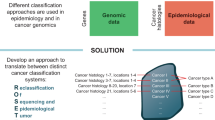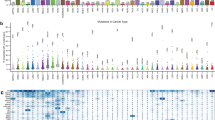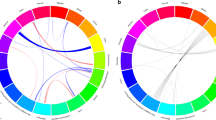Abstract
The past decade has seen great strides in our understanding of the genetic basis of human disease. Arguably, the most profound impact has been in the area of cancer genetics, where the explosion of genomic sequence and molecular profiling data has illustrated the complexity of human malignancies. In a tumor cell, dozens of different genes may be aberrant in structure or copy number, and hundreds or thousands of genes may be differentially expressed. A number of familial cancer genes with high-penetrance mutations have been identified, but the contribution of low-penetrance genetic variants or polymorphisms to the risk of sporadic cancer development remains unclear. Studies of the complex somatic genetic events that take place in the emerging cancer cell may aid the search for the more elusive germline variants that confer increased susceptibility. Insights into the molecular pathogenesis of cancer have provided new strategies for treatment, but a deeper understanding of this disease will require new statistical and computational approaches for analysis of the genetic and signaling networks that orchestrate individual cancer susceptibility and tumor behavior.
This is a preview of subscription content, access via your institution
Access options
Subscribe to this journal
Receive 12 print issues and online access
We are sorry, but there is no personal subscription option available for your country.
Buy this article
- Purchase on SpringerLink
- Instant access to full article PDF
Prices may be subject to local taxes which are calculated during checkout

Katie Ris

Katie Ris


Katie Ris

Katie Ris
Similar content being viewed by others
References
Knudson, A.G. Jr. Mutation and cancer: statistical study of retinoblastoma. Proc. Natl. Acad. Sci. USA 68, 820–823 (1971).
Friend, S.H. et al. A human DNA segment with properties of the gene that predisposes to retinoblastoma and osteosarcoma. Nature 323, 643–646 (1986).
Doll, R. & Peto, R. The causes of cancer: quantitative estimates of avoidable risks of cancer in the United States today. J. Natl. Cancer Inst. 66, 1191–1308 (1981).
Peto, J. Cancer epidemiology in the last century and the next decade. Nature 411, 390–395 (2001).
Buell, P. & Dunn, J.E. Cancer mortality among Japanese Issei and Nisei of California. Cancer 18, 656–664 (1965).
Newman, B., Austin, M.A., Lee, M. & King, M.C. Inheritance of human breast cancer: evidence for autosomal dominant transmission in high-risk families. Proc. Natl. Acad. Sci. USA 85, 3044–3048 (1988).
Claus, E.B., Risch, N. & Thompson, W.D. Genetic analysis of breast cancer in the cancer and steroid hormone study. Am. J. Hum. Genet. 48, 232–242 (1991).
Peto, J. in Cancer Incidence in Defined Populations Vol. 4, Banbury Report (eds. Cairns, J., Lyon, J.L. & Skolnik, M.) 203–213 (Cold Spring Harbor Press, Cold Spring Harbor, NY, 1980).
Hall, J.M. et al. Linkage of early-onset familial breast cancer to chromosome 17q21. Science 250, 1684–1689 (1990).
Weinberg, R.A. The retinoblastoma protein and cell cycle control. Cell 81, 323–330 (1995).
Linzer, D.I. & Levine, A.J. Characterization of a 54K dalton cellular SV40 tumor antigen present in SV40-transformed cells and uninfected embryonal carcinoma cells. Cell 17, 43–52 (1979).
Lane, D.P. & Crawford, L.V. Tantigen is bound to a host protein in SV40-transformed cells. Nature 278, 261–263 (1979).
Baker, S.J. et al. Chromosome 17 deletions and p53 gene mutations in colorectal carcinomas. Science 244, 217–221 (1989).
Malkin, D. et al. Germ line p53 mutations in a familial syndrome of breast cancer, sarcomas, and other neoplasms. Science 250, 1233–1238 (1990).
Kinzler, K.W. & Vogelstein, B. Colorectal tumors. In The Genetic Basis of Human Cancer (ed. Kinzler, K.W.) 583–612 (McGraw Hill, New York 2002).
Stambolic, V. et al. Negative regulation of PKB/Akt-dependent cell survival by the tumor suppressor PTEN. Cell 95, 29–39 (1998).
Eng, C. & Parsons, R. Cowden syndrome. In The Genetic Basis of Human Cancer (ed. Kinzler, K.W.) 527–537 (McGraw Hill, New York 2002).
Linehan, W.M., Zbar, B. & Klausner, R.D. Renal cancer. In The Genetics Basis of Human Cancer (ed. Kinzler, K.W.) 449–474 (McGraw Hill, New York 2002).
Venkitaraman, A.R. Cancer susceptibility and the functions of BRCA1 and BRCA2. Cell 108, 171–182 (2002).
Hoeijmakers, J.H. Genome maintenance mechanisms for preventing cancer. Nature 411, 366–374 (2001).
Schor, S.L., Schor, A.M., Durning, P. & Rushton, G. Skin fibroblasts obtained from cancer patients display foetal-like migratory behaviour on collagen gels. J. Cell Sci. 73, 235–244 (1985).
Olumi, A.F. et al. Carcinoma-associated fibroblasts direct tumor progression of initiated human prostatic epithelium. Cancer Res. 59, 5002–5011 (1999).
Kurose, K. et al. Frequent somatic mutations in PTEN. and TP53 are mutually exclusive in the stroma of breast carcinomas. Nat. Genet. 32, 355–357 (2002).
Zhu, Y., Ghosh, P., Charnay, P., Burns, D.K. & Parada, L.F. Neurofibromas in NF1: Schwann cell origin and role of tumor environment. Science 296, 920–922 (2002).
Holtzman, N.A. & Marteau, T.M. Will genetics revolutionize medicine? N. Engl. J. Med. 343, 141–144 (2000).
Bell, J. The new genetics in clinical practice. Br. Med. J. 316, 618–620 (1998).
Pharoah, P.D. et al. Polygenic susceptibility to breast cancer and implications for prevention. Nat. Genet. 31, 33–36 (2002).
Lichtenstein, P. et al. Environmental and heritable factors in the causation of cancer—analyses of cohorts of twins from Sweden, Denmark, and Finland. N. Engl. J. Med. 343, 78–85 (2000).
Cui, J. et al. After BRCA1 and BRCA2—what next? Multifactorial segregation analyses of three-generation, population-based Australian families affected by female breast cancer. Am. J. Hum. Genet. 68, 420–31 (2001).
Antoniou, A.C. et al. A comprehensive model for familial breast cancer incorporating BRCA1, BRCA2 and other genes. Br. J. Cancer 86, 76–83 (2002).
Peto, J. Breast cancer susceptibility—a new look at an old model. Cancer Cell 1, 411–412 (2002).
Wright, A.F. & Hastie, N.D. Complex genetic diseases: controversy over the Croesus code. Genome Biol. 2, COMMENT2007 (2001).
Cardon, L.R. & Bell, J.I. Association study designs for complex diseases. Nat. Rev. Genet. 2, 91–99 (2001).
Botstein, D. & Rich, N. Discovering genotypes underlying human phenotypes: past successes for mendelian disease, future approaches for complex disease. Nat. Genet., 33, 228–237 (2003)
Gabriel, S.B. et al. The structure of haplotype blocks in the human genome. Science 296, 2225–2229 (2002).
Couzin, J. Genomics. New mapping project splits the community. Science 296, 1391–3139 (2002).
Horikawa, Y. et al. Genetic variation in the gene encoding calpain-10 is associated with type 2 diabetes mellitus. Nat. Genet. 26, 163–175 (2000).
Balmain, A. & Nagase, H. Cancer resistance genes in mice: models for the study of tumour modifiers. Trends Genet. 14, 139–144 (1998).
Tripodis, N., Hart, A.A., Fijneman, R.J. & Demant, P. Complexity of lung cancer modifiers: mapping of thirty genes and twenty-five interactions in half of the mouse genome. J. Natl. Cancer Inst. 93, 1484–1491 (2001).
Nagase, H., Mao, J.H. & Balmain, A. A subset of skin tumor modifier loci determines survival time of tumor-bearing mice. Proc. Natl. Acad. Sci. USA 96, 15032–15037 (1999).
Saran, A. et al. Genetics of chemical carcinogenesis: analysis of bidirectional selective breeding inducing maximal resistance or maximal susceptibility to 2-stage skin tumorigenesis in the mouse. Int. J. Cancer 88, 424–431 (2000).
Fijneman, R.J., de Vries, S.S., Jansen, R.C. & Demant, P. Complex interactions of new quantitative trait loci, Sluc1, Sluc2, Sluc3, and Sluc4, that influence the susceptibility to lung cancer in the mouse. Nat. Genet. 14, 465–467 (1996).
van Wezel, T. et al. Gene interaction and single gene effects in colon tumour susceptibility in mice. Nat. Genet. 14, 468–470 (1996).
Nagase, H., Mao, J.H., de Koning, J.P., Minami, T. & Balmain, A. Epistatic interactions between skin tumor modifier loci in interspecific (spretus/musculus) backcross mice. Cancer Res. 61, 1305–1308 (2001).
Rouse, J. & Jackson, S.P. Interfaces between the detection, signaling, and repair of DNA damage. Science 297, 547–551 (2002).
Kolodner, R.D., Putnam, C.D. & Myung, K. Maintenance of genome stability in Saccharomyces cerevisiae. Science 297, 552–557 (2002).
Maser, R.S. & DePinho, R.A. Connecting chromosomes, crisis, and cancer. Science 297, 565–569 (2002).
Lengauer, C., Kinzler, K.W. & Vogelstein, B. Genetic instabilities in human cancers. Nature 396, 643–649 (1998).
Friedberg, E.C. How nucleotide excision repair protects against cancer. Nat. Rev. Cancer 1, 22–33 (2001).
Ionov, Y., Peinado, M.A., Malkhosyan, S., Shibata, D. & Perucho, M. Ubiquitous somatic mutations in simple repeated sequences reveal a new mechanism for colonic carcinogenesis. Nature 363, 558–561 (1993).
Thibodeau, S.N., Bren, G. & Schaid, D. Microsatellite instability in cancer of the proximal colon. Science 260, 816–819 (1993).
Parsons, R. et al. Hypermutability and mismatch repair deficiency in RER+ tumor cells. Cell 75, 1227–1236 (1993).
Lynch, H.T. & de la Chapelle, A. Genetic susceptibility to non-polyposis colorectal cancer. J. Med. Genet. 36, 801–818 (1999).
Rampino, N. et al. Somatic frameshift mutations in the BAX gene in colon cancers of the microsatellite mutator phenotype. Science 275, 967–969 (1997).
Parsons, R. et al. Microsatellite instability and mutations of the transforming growth factor beta type II receptor gene in colorectal cancer. Cancer Res. 55, 5548–5550 (1995).
Hastie, N.D. et al. Telomere reduction in human colorectal carcinoma and with ageing. Nature 346, 866–868 (1990).
Blackburn, E.H. & Challoner, P.B. Identification of a telomeric DNA sequence in Trypanosoma brucei. Cell 36, 447–457 (1984).
Cahill, D.P. et al. Mutations of mitotic checkpoint genes in human cancers. Nature 392, 300–303 (1998).
Jallepalli, P.V. & Lengauer, C. Chromosome segregation and cancer: cutting through the mystery. Nat. Rev. Cancer 1, 109–117 (2001).
Fodde, R., Smits, R. & Clevers, H. APC, signal transduction and genetic instability in colorectal cancer. Nat. Rev. Cancer 1, 55–67 (2001).
Bischoff, J.R. et al. A homologue of Drosophila aurora kinase is oncogenic and amplified in human colorectal cancers. EMBO J. 17, 3052–3065 (1998).
Zhou, H. et al. Tumour amplified kinase STK15/BTAK induces centrosome amplification, aneuploidy and transformation. Nat. Genet. 20, 189–193 (1998).
Fukasawa, K., Choi, T., Kuriyama, R., Rulong, S. & Vande Woude, G.F. Abnormal centrosome amplification in the absence of p53. Science 271, 1744–1747 (1996).
Vogelstein, B., Lane, D. & Levine, A.J. Surfing the p53 network. Nature 408, 307–310 (2000).
Fearon, E.R. & Vogelstein, B. A genetic model for colorectal tumorigenesis. Cell 61, 759–767 (1990).
Nowell, P.C. The clonal evolution of tumor cell populations. Science 194, 23–28 (1976).
Frame, S. & Balmain, A. Integration of positive and negative growth signals during ras pathway activation in vivo. Curr. Opin. Genet. Dev. 10, 106–113 (2000).
Marx, J. Debate surges over the origins of genomic defects in cancer. Science 297, 544–546 (2002).
Jonason, A.S. et al. Frequent clones of p53-mutated keratinocytes in normal human skin. Proc. Natl. Acad. Sci. USA 93, 14025–14029 (1996).
Deng, G., Lu, Y., Zlotnikov, G., Thor, A.D. & Smith, H.S. Loss of heterozygosity in normal tissue adjacent to breast carcinomas. Science 274, 2057–2059 (1996).
Rehman, I., Quinn, A.G., Healy, E. & Rees, J.L. High frequency of loss of heterozygosity in actinic keratoses, a usually benign disease. Lancet 344, 788–789 (1994).
Gong, G. et al. Genetic changes in paired atypical and usual ductal hyperplasia of the breast by comparative genomic hybridization. Clin. Cancer Res. 7, 2410–2414 (2001).
Shaaban, A.M. et al. Histopathologic types of benign breast lesions and the risk of breast cancer: case-control study. Am J. Surg. Pathol. 26, 421–430 (2002).
Brown, K., Strathdee, D., Bryson, S., Lambie, W. & Balmain, A. The malignant capacity of skin tumours induced by expression of a mutant H-ras transgene depends on the cell type _targeted. Curr. Biol. 8, 516–524 (1998).
Pinkel, D. et al. Fluorescence in situ hybridization with human chromosome-specific libraries: detection of trisomy 21 and translocations of chromosome 4. Proc. Natl. Acad. Sci. USA 85, 9138–9142 (1988).
Gray, J.W. & Collins, C. Genome changes and gene expression in human solid tumors. Carcinogenesis 21, 443–452 (2000).
Hayashizaki, Y. et al. Restriction landmark genomic scanning method and its various applications. Electrophoresis 14, 251–258 (1993).
Kallioniemi, A. et al. Comparative genomic hybridization for molecular cytogenetic analysis of solid tumors. Science 258, 818–821 (1992).
Ginzinger, D.G. et al. Measurement of DNA copy number at microsatellite loci using quantitative PCR analysis. Cancer Res. 60, 5405–5409 (2000).
Lisitsyn, N. & Wigler, M. Cloning the differences between two complex genomes. Science 259, 946–951 (1993).
Zardo, G. et al. Integrated genomic and epigenomic analyses pinpoint biallelic gene inactivation in tumors. Nat. Genet. 32, 453–458 (2002).
Davies, H. et al. Mutations of the BRAF gene in human cancer. Nature 417, 949–954 (2002).
Schena, M., Shalon, D., Davis, R.W. & Brown, P.O. Quantitative monitoring of gene expression patterns with a complementary DNA microarray. Science 270, 467–470 (1995).
Bernard, P.S. & Wittwer, C.T. Real-time PCR technology for cancer diagnostics. Clin. Chem. 48, 1178–1185 (2002).
Conrads, T.P., Anderson, G.A., Veenstra, T.D., Pasa-Tolic, L. & Smith, R.D. Utility of accurate mass tags for proteome-wide protein identification. Anal Chem. 72, 3349–3354 (2000).
Knezevic, V. et al. Proteomic profiling of the cancer microenvironment by antibody arrays. Proteomics 1, 1271–1278 (2001).
Heisterkamp, N., Stam, K., Groffen, J., de Klein, A. & Grosveld, G. Structural organization of the BCR gene and its role in the Ph′ translocation. Nature 315, 758–761 (1985).
Bernardi, R., Grisendi, S. & Pandolfi, P.P. Modelling haematopoietic malignancies in the mouse and therapeutical implications. Oncogene 21, 3445–3458 (2002).
Druker, B.J. et al. Activity of a specific inhibitor of the BCR-ABL tyrosine kinase in the blast crisis of chronic myeloid leukemia and acute lymphoblastic leukemia with the Philadelphia chromosome. N. Engl. J. Med. 344, 1038–1042 (2001).
Kallioniemi, O.P. et al. ERBB2 amplification in breast cancer analyzed by fluorescence in situ hybridization. Proc. Natl. Acad. Sci. USA 89, 5321–5325 (1992).
Vogel, C.L. et al. First-line Herceptin monotherapy in metastatic breast cancer. Oncology 61 (suppl. 2), 37–42 (2001).
Lyons, J.F., Wilhelm, S., Hibner, B. & Bollag, G. Discovery of a novel Raf kinase inhibitor. Endocr. Relat. Cancer 8, 219–225 (2001).
Balmain, A. Cancer: new-age tumour suppressors. Nature 417, 235–237 (2002).
Jaenisch R, & Adrian, B. Epigenetic regulation: how the genome integrates intrinsic and environmental signals. Nat. Genet., 33, 245–254 (2003)
Baylin, S. & Bestor, T.H. Altered methylation patterns in cancer cell genomes: cause or consequence? Cancer Cell 1, 299–305 (2002).
Jones, P.A. & Baylin, S.B. The fundamental role of epigenetic events in cancer. Nat. Rev. Genet. 3, 415–428 (2002).
Venkatachalam, S. et al. Retention of wild-type p53 in tumors from p53 heterozygous mice: reduction of p53 dosage can promote cancer formation. EMBO J. 17, 4657–4667 (1998).
Tang, B. et al. Transforming growth factor-β1 is a new form of tumor suppressor with true haploid insufficiency. Nat. Med. 4, 802–807 (1998).
Fero, M.L., Randel, E., Gurley, K.E., Roberts, J.M. & Kemp, C.J. The murine gene p27Kip1 is haplo-insufficient for tumour suppression. Nature 396, 177–180 (1998).
Inoue, K., Zindy, F., Randle, D.H., Rehg, J.E. & Sherr, C.J. Dmp1 is haplo-insufficient for tumor suppression and modifies the frequencies of Arf and p53 mutations in Myc-induced lymphomas. Genes Dev. 15, 2934–2939 (2001).
Ji, L. et al. Expression of several genes in the human chromosome 3p21.3 homozygous deletion region by an adenovirus vector results in tumor suppressor activities in vitro and in vivo. Cancer Res. 62, 2715–2720 (2002).
You, M. et al. Parental bias of Ki-ras oncogenes detected in lung tumors from mouse hybrids. Proc. Natl. Acad. Sci. USA 89, 5804–5808 (1992).
Linardopoulos, S., Silva, S., Klein, G. & Balmain, A. Allele-specific loss or imbalance of chromosomes 9, 15, and 16 in B-cell tumors from interspecific F1 hybrid mice carrying Emu-c-myc or N-myc transgenes. Int. J. Cancer 88, 920–927 (2000).
Hodgson, G. et al. Genome scanning with array CGH delineates regional alterations in mouse islet carcinomas. Nat. Genet. 29, 459–464 (2001).
Sidransky, D. Emerging molecular markers of cancer. Nat. Rev. Cancer 2, 210–219 (2002).
Davies, R.J. et al. Analysis of minichromosome maintenance proteins as a novel method for detection of colorectal cancer in stool. Lancet 359, 1917–1919 (2002).
van de Vijver, M.J. et al. A gene-expression signature as a predictor of survival in breast cancer. N. Engl. J. Med. 347, 1999–2009 (2002).
Albert, R., Jeong, H. & Barabasi, A.L. Error and attack tolerance of complex networks. Nature 406, 378–382 (2000).
Author information
Authors and Affiliations
Corresponding author
Rights and permissions
About this article
Cite this article
Balmain, A., Gray, J. & Ponder, B. The genetics and genomics of cancer. Nat Genet 33 (Suppl 3), 238–244 (2003). https://doi.org/10.1038/ng1107
Issue Date:
DOI: https://doi.org/10.1038/ng1107
This article is cited by
-
NME1 and DCC variants are associated with susceptibility and tumor characteristics in Mexican patients with colorectal cancer
Journal of the Egyptian National Cancer Institute (2024)
-
ALAN is a computational approach that interprets genomic findings in the context of tumor ecosystems
Communications Biology (2023)
-
Review on metal nanoparticles as nanocarriers: current challenges and perspectives in drug delivery systems
Emergent Materials (2022)
-
Frequent Downregulation and Promoter Hypermethylation of DLC1: Relationship with Clinical Outcome in Gallbladder Cancer
Journal of Gastrointestinal Cancer (2022)
-
Newly synthesized metal complexes of sulfonamides: DNA cleavage, BRCA1 gene interaction, expression analysis, antioxidant and antiglycation studies
Chemical Papers (2022)



